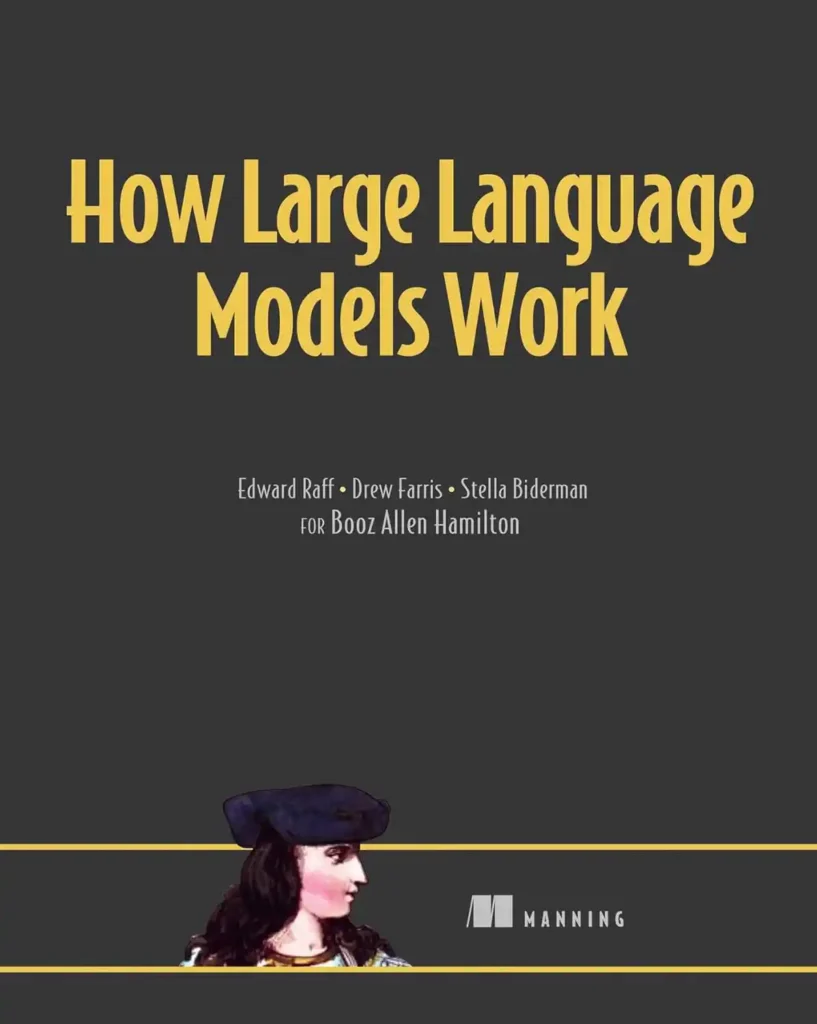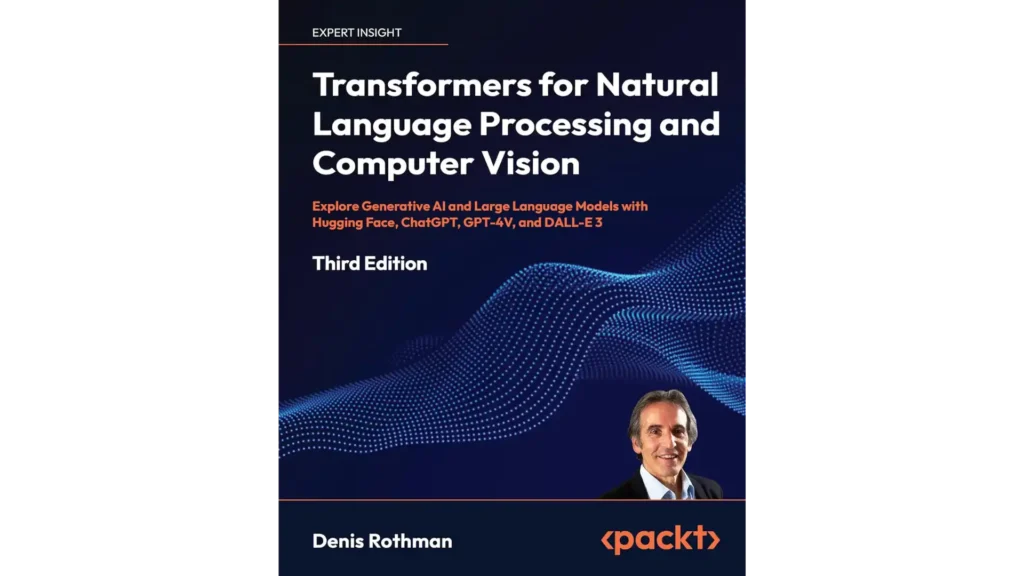
We interact with large language models (LLMs) daily, whether writing emails with Copilot, chatting with GPT, or using AI-powered search tools. But what really happens behind the scenes when you prompt these models? How do they generate text, interpret queries, or sometimes produce misleading answers?
How Large Language Models Work (affiliate link) by Edward Raff, Drew Farris, and Stella Biderman is a clear, practical guide to how LLMs work. The authors, all experts at Booz Allen Hamilton, bring experience as AI research leaders and practitioners, offering valuable insights into training, deployment, and real-world applications.
Published by Manning Publications, the book explores how LLMs work, how they’re trained, where they perform well or fall short, and why these details matter in practice. It covers topics like tokenization, attention, training, and deployment in a clear, non-technical way.
In this review, I’ll share the most valuable lessons from the book, whether you’re a student, developer, or business leader seeking a clear understanding of the AI technology shaping our future.
9 Key Lessons from How Large Language Models Work
How Large Language Models Work bridges the technical concepts behind LLMs with real-world challenges in business, technology, and research. The authors structure the book around key lessons that explain how LLMs function, how they are trained and refined, and how they can be used effectively in practice.
1. LLMs are prediction engines, not thinkers
The authors emphasize that large language models like ChatGPT are not intelligent in the way humans are. They don’t “think” or “understand” language. Instead, they are trained to predict the next word based on massive amounts of text data. This predictive power allows them to generate fluent and often impressive responses, but it doesn’t mean they grasp meaning or context.
Rather than simulating human reasoning, LLMs transform input text into internal representations and rely on pattern recognition to produce output. This design enables useful applications like summarization, question answering, or code completion, but it also means LLMs can fail in tasks that require true comprehension or reasoning. Understanding this limitation helps set the right expectations when using LLMs in real-world applications.
2. Tokenization is how machines see language
Before a large language model can process text, it must break it down into smaller units called tokens. These tokens might be whole words, parts of words, or even individual characters, depending on the model’s vocabulary. This process, called tokenization, is the first and most essential step in helping LLMs convert human language into a format they can handle, which is numerical form.
The book explains how tools like Byte Pair Encoding (BPE) help segment words efficiently based on patterns in large training datasets. However, tokenization is not perfect. Since LLMs only see numeric tokens and not full words, they can miss relationships like prefixes, suffixes, or numeric patterns. This affects how models perform in areas like math or domain-specific tasks unless they are carefully fine-tuned with custom tokens.
3. Transformers Decoded: How LLMs Actually Work
Transformers are the core engine behind every modern LLM. They convert input tokens into internal vector representations, process them using layers of attention, and finally generate output by predicting the most likely next token. The book explains how this architecture uses embeddings, positional encoding, and self-attention to interpret relationships between words, even when they are far apart in a sentence. Decoder-only transformers like ChatGPT work in an autoregressive way, generating one token at a time based on all previous ones. This chapter also highlights how randomness during token selection can make model outputs more creative or more predictable, depending on your needs.
Want to learn more about transformers? Dive into my book review: 10 Insights from Transformers for NLP and Computer Vision
4. How LLMs Learn: Mimicking Patterns, Not Thinking
LLMs are not programmed with fixed rules like traditional software. Instead, they learn patterns in language by analyzing massive amounts of text and predicting the next token in a sequence. Through repeated prediction and feedback, they gradually adjust their internal parameters using a method called gradient descent.
A loss function measures how far off the model’s predictions are, and training involves minimizing this loss across millions of examples. This enables LLMs to mimic human-like text generation. However, because their objective is limited to token prediction and not true understanding, they can struggle with unfamiliar tasks or deeper comprehension.
5. How to Guide and Refine LLM Behavior
LLMs are not locked into a single behavior. Their outputs can be influenced and refined through several methods. The book outlines four key intervention points: during data collection, base model training, fine-tuning, and post-processing of outputs. Among these, fine-tuning is the most effective for most users, as it allows the model to adapt to specific goals without needing to retrain from scratch.
Supervised fine-tuning helps tailor a model to a domain, while reinforcement learning from human feedback (RLHF) lets developers reward more desirable outputs. Other approaches like Retrieval Augmented Generation (RAG) feed relevant information into prompts from external sources, improving accuracy and control. Together, these methods give developers a powerful toolkit to shape LLM behavior for practical applications.
6. LLMs Beyond Text: Code, Math, and Vision
How Large Language Models Work explains that while LLMs are best known for their power in natural language processing (NLP), their capabilities extend far beyond text. In software development, they use tools like syntax checkers and compilers to generate and correct code. In mathematics, LLMs must be adapted to handle symbols and numbers, often relying on external tools to improve accuracy. In computer vision, transformers process images by turning them into patches, similar to how tokens work in NLP. This flexibility enables LLMs to support tasks like image captioning and generation.
New to NLP? Start with Mastering NLP: A Journey Through Sentiment Analysis.
7. The Truth About LLM Capabilities and Constraints
The book How Large Language Models Work highlights common misconceptions about LLMs and clearly outlines their strengths and limitations. These models excel in scale, speed, and repetitive tasks. They run continuously, adapt to varying workloads, and deliver useful outputs for problems that don’t require precise answers. This makes them ideal for many real-world applications, especially when “close enough” is good enough.
However, the authors also explain why understanding the limits of LLMs is critical. These models cannot self-improve and often struggle with truly novel or adversarial situations. Unlike humans, they can’t plan or grasp deeper context beyond their training data. They also fall short on complex algorithmic problems that need exact answers. For such tasks, prompt engineering, retrieval-augmented input, or fine-tuning can help, though even these techniques have boundaries.
8. Designing Smarter Solutions with LLMs
The authors of How Large Language Models Work explain that designing with LLMs begins by understanding the risk and cost of errors. If the risk is low, a chatbot might be suitable. But for sensitive tasks, it is better to adjust the workflow, sometimes by including human oversight or shifting automation to safer areas.
They also describe how LLMs can create embeddings that make it easier to apply traditional machine learning techniques like clustering and outlier detection. Tools such as retrieval-augmented generation, feedback cycles, and clear interface design help improve reliability. The focus should always be on creating systems that match what users truly need rather than just their stated input.
9. The Ethics Behind Building and Using LLMs
LLMs are useful for many tasks, but their broad capabilities make it hard to predict all possible uses. This raises concerns, especially when automating complex knowledge work. The risks grow as we rely more on them in decision making.
Fears about misalignment and self improving models highlight the need for careful oversight. Even with alignment efforts, automating knowledge tasks may have unknown long-term effects.
Training data also brings ethical issues. Using online content without clear permission raises fairness concerns. As AI generated data increases, it may affect the quality of future models, making responsible development more important than ever.
Who Should Read This Book
How Large Language Models Work is perfect for anyone curious about the inner workings of LLMs, from beginners who have used tools like OpenAI’s ChatGPT, Google’s Gemini, Anthropic’s Claude, or Microsoft’s Copilot, to developers, data scientists, and tech leaders exploring real-world applications. It offers a solid foundation for those building or managing LLM-powered systems.
The book clearly explains core concepts like transformers, attention, training methods, deployment strategies, and limitations, making it valuable whether you’re learning, applying, or leading AI efforts in your organization.
Final Thoughts
How Large Language Models Work is a thoughtful and timely guide that explains the inner mechanics, limitations, and real-world implications of today’s most powerful AI systems. It does not overwhelm with math or code but instead builds your understanding step by step, from tokenization and transformers to ethical concerns and deployment strategies.
What makes this book especially valuable is how it separates hype from reality. It equips you with a clear mental model of how LLMs operate, where they excel, and where they fall short. Whether you’re a developer, business leader, or curious reader, this book gives you the clarity and confidence to use LLMs more thoughtfully and responsibly.
Get the book here
How Large Language Models Work by Edward Raff, Drew Farris, and Stella Biderman is available from Manning Publications and also on Amazon (affiliate link). If you’re ready to understand LLMs at their core, this guide is a must-read.
Disclosure: This article about How Large Language Models Work contains affiliate links. If you buy through these links, we may earn a small commission at no extra cost to you. It helps us keep creating free content on Noro Insight.


